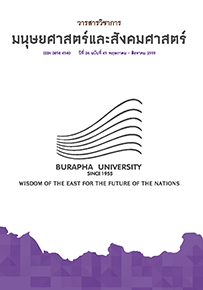กลวิธีการเรียนรู้คำศัพท์ในสภาพแวดล้อมที่แตกต่างของผู้เรียนไทยที่เรียนทางด้านธุรกิจในระดับอุดมศึกษา Vocabulary Learning Strategies in Different Environments of Thai Business Students at Tertiary Level
Main Article Content
Abstract
บทคัดย่อ
การวิจัยครั้งนี้มีจุดประสงค์เพื่อศึกษาการใช้กลวิธีการเรียนรู้คำศัพท์ในสภาพแวดล้อมที่แตกต่างกันในห้องเรียนและนอกห้องเรียนของผู้เรียนชาวไทยที่เรียนทางด้านธุรกิจในระดับอุดมศึกษา โดยจำแนกตามระดับความสามารถทางภาษากลุ่มตัวอย่าง ได้แก่ นักศึกษาชั้นปีที่ 3 สาขาบริหารธุรกิจ จำนวน 42 คน ที่ลงทะเบียนเรียนรายวิชาการอ่านภาษาอังกฤษธุรกิจ ในภาคเรียนที่ 2 ปีการศึกษา 2557 เครื่องมือที่ใช้ในการวิจัยประกอบไปด้วยแบบสอบถามเกี่ยวกับการใช้กลวิธีการเรียนรู้คำศัพท์ที่ประยุกต์มาจากกรอบแนวคิดของ Schmitt (1997) และแบบทดสอบคำศัพท์ทางด้านธุรกิจ สถิติที่ใช้ในการวิเคราะห์ข้อมูล ได้แก่ ค่าร้อยละ การวิเคราะห์ความแปรปรวนทางเดียว และค่าสถิติของเซฟเฟ่ (Scheffe’s test) ผลการวิจัย พบว่านักศึกษาไทยที่เรียนทางด้านธุรกิจใช้กลวิธีการเรียนรู้ด้วยตนเอง (Determination) บ่อยที่สุดในบริบทในห้องเรียน และใช้กลวิธีด้านอภิปัญญา (Metacognitive) บ่อยที่สุดในบริบทนอกห้องเรียน ในขณะที่กลวิธีด้านความจำ (Memory) เป็นกลวิธีที่นักศึกษาใช้น้อยที่สุดในทุก ๆ บริบท นอกจากนี้ ยังพบว่านักศึกษาที่มีความสามารถทางภาษาสูงและนักศึกษาที่มีความสามารถทางภาษาต่ำ ใช้กลวิธีการเรียนรู้คำศัพท์โดยภาพรวมที่แตกต่างกันอย่างไม่มีนัยสำคัญทางสถิติที่ระดับ .05
Abstract
This research study was aimed to investigate vocabulary learning strategies employed in the different environments: inside and outside classrooms, by Thai Business students at undergraduate level, which purposively grouped regarding language proficiency. The participants were 42 third- year Business administration students who enrolled in the course of English Reading Business Course in the second semester of Academic year 2014. The research instruments were vocabulary learning strategy questionnaire adopted from Schitt’s taxonomy (1997), and Business vocabulary test. Statistical techniques were used for data analysis in this study were Percentage, ANOVA and Scheffe-pos-hoc test. Findings indicated that the most frequency used in in-class setting was Determination strategies, while the most frequency used in out-of-class setting were Metacognitive strategies and the least often used both inside and outside the classrooms was Memory strategies. Focusing on language proficiency, the result found that the overall vocabulary learning strategies employed between thehigh-proficiency level students and the low-proficiency level students were different but not significance level of .05.
Downloads
Article Details
บทความทุกบทความเป็นลิขสิทธิ์ของวารสารวิชาการมนุษยศาสตร์และสังคมศาสตร์ มหาวิทยาลัยบูรพาเท่านั้น

